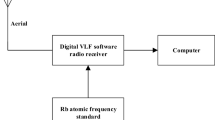Summary
Long-period fading observed in recordings ofVLF andLF atmospherics in meteorologically clear nights exhibits a good correlation with the geomagnetic activity indexA p . The fading phenomenon occurs more frequently in the case of integrated field intensity of atmospherics than in the case of andLF radio signal transmitted from a certain station. The phenomenon has been analyzed for the monsoon and postmonsoon periods separately, and the results have been discussed in relation to the large-scale travelling ionospheric distubances (LS TID). The modal value of fade periods forVLF andLF atmospherics has been found to be about one hour. It is noted that the correlation of the fade amplitude of highttimeVLF andLF atmospherics versus the geomagnetic activity is frequency dependent and increases fromVLF toLF.
Similar content being viewed by others
References
Bhattacharya, A. B., Sarkar, S. K., Sen, A. K., 1980: Regular behaviour of the field intensity ofVLF atmospherics over Calcutta.J. Inst. Electron. Telecom. Eng.,26, 279–282.
Davis, M. J., Rosa, A. V., 1969. Travelling ionospheric disturbances originating in the auroral oval during polar substorms.J. Geophys. Res.,74, 5721–5735.
Davis, M. J., 1971: On polar substorms as the source of large scale travelling ionospheric disturbances.J. Geophys. Res.,76, 4525–4533.
Morgan, A. D., 1967: An observed correlation between the occurrence of sporadic-E and magnetic activity.J. Atmos. Terr. Phys.,29, 1633–1635.
Roble, R. G., Richmond, A. D., Oliver, W. D., Harper, R. M., 1978: Ionospheric effect of the gravity wave launched by the September 18, 1974, sudden commencement.J. Geophys. Res.,83, 999–1009.
Sarkar, S. K., Bhattacharya, A. B., 1980: Sea thunderstorms and associated atmospherics.Mausam,31, 465–467.
Sarkar, S. K., De, B. K., 1985: Meteorological effect on long-distance 40 kHz signal.Arch. Met. Geoph. Biocl.,33, 365–379
Sen, A. K., 1967: Long period fading ofVLF atmospherics.J. Geophys. Res.,72, 1747–1748.
Sen, A. K., Saha, B., 1973: Nighttime fading of anLF radio signal due to irregularities in lower ionosphere.J. Rad. Space. Sci.,2, 297–298.
Sen, A. K., Saha, B., 1974: Long-period fading of anLF radiosignal in relation to geomagnetic activity.J. Geophys. Res. 79, 1567–1568.
Sen, A. K., Sarkar, S. K., Bhattacharya, A. B., 1979: Anomaly inVLF atmospherics during flood rainy days over Calcutta during 27–30 September 1978.Ind J. Rad. Space Phys. 8, 139–142.
Solar-Geophysical Data, explanation of data reports (February 1982) No. 450 (supplement).
Yeh, K. C., Liu, C. H., 1974: Acoustic-gravity waves in the upper atmosphere.Rev. Geophys. Space Phys.,12, 193–216.
Author information
Authors and Affiliations
Rights and permissions
About this article
Cite this article
De, B.K., Sarkar, S.K. Nighttime fading ofVLF andLF atmospherics in relation to geomagnetic activity. Meteorl. Atmos. Phys. 55, 235–242 (1995). https://doi.org/10.1007/BF01029830
Issue Date:
DOI: https://doi.org/10.1007/BF01029830




